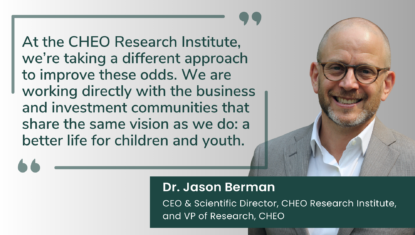Jason Berman completed a clinical fellowship in Pediatric Hematology/Oncology at the Boston Children’s Hospital and his post-doctoral training at the Dana-Farber Cancer Institute funded by the prestigious Pediatric Scientist Development Program. Jason was recruited to Dalhousie University and the IWK Health Centre in 2005 as the named MSC Clinician-Scientist in Pediatric Oncology. Over the next 14 years, he ascended through the academic ranks to become Professor of Pediatrics, Microbiology & Immunology and Pathology at Dalhousie University and Associate Chair Research for the Department of Pediatrics.
In 2017, he assumed the role of interim Vice President Research, Innovation and Knowledge Translation at the IWK Health Centre. He relocated to Ottawa in 2019 to assume the role of CEO and Scientific Director of the CHEO Research Institute and the Vice President Research at CHEO. He is a full professor in the Department of Pediatrics at the University of Ottawa.
Related News
Research Projects
-
High-dose AraC is Essential for the Treatment of ML-DS Independent of Post-Induction MRD: Results of COG AAML1531
28/07/2021
-
The identification of dual protective agents against cisplatin-induced oto-and nephrotoxicity using the zebrafish model
28/07/2020
Dose-limiting toxicities for cisplatin administration, including ototoxicity and nephrotoxicity, impact the clinical utility of this effective chemotherapy agent and lead to lifelong complications, particularly in pediatric cancer survivors. Using a two-pronged drug screen employing the zebrafish lateral line as an in vivo readout for ototoxicity and kidney cell-based nephrotoxicity assay, we screened 1280 compounds and identified 22 that were both oto- and nephroprotective.
-
Genome Editing in Zebrafish Using High-Fidelity Cas9 Nucleases: Choosing the Right Nuclease for the Task
01/02/2020
In summary, the developed new high-fidelity Cas9 vectors will enable researchers to perform much more accurate genome editing.
-
The Zebrafish Xenograft Platform-A Novel Tool for Modeling KSHV-Associated Diseases
20/12/2019
We found that PEL cell proliferation in xenografts was dependent on the host hypoxia-dependent translation initiation factor, eukaryotic initiation factor 4E2 (eIF4E2). This demonstrates that the zebrafish yolk sac is a functionally hypoxic environment, and xenografted cells must switch to dedicated hypoxic gene expression machinery to survive and proliferate. The establishment of the PEL xenograft model enables future studies that exploit the innate advantages of the zebrafish as a model for genetic and pharmacologic screens.
-
Humanized zebrafish enhance human hematopoietic stem cell survival and promote acute myeloid leukemia clonal diversity
01/12/2019
We determined that patient-derived leukemias transplanted into GSS zebrafish exhibit broader clonal representation compared to transplants into control hosts. GSS zebrafish incorporating error-corrected RNA sequencing establish a new standard for zebrafish xenotransplantation that more accurately recapitulates the human context, providing a more representative cost-effective preclinical model system for evaluating personalized response-based treatment in leukemia and therapies to expand human hematopoietic stem and progenitor cells in the transplant setting.




